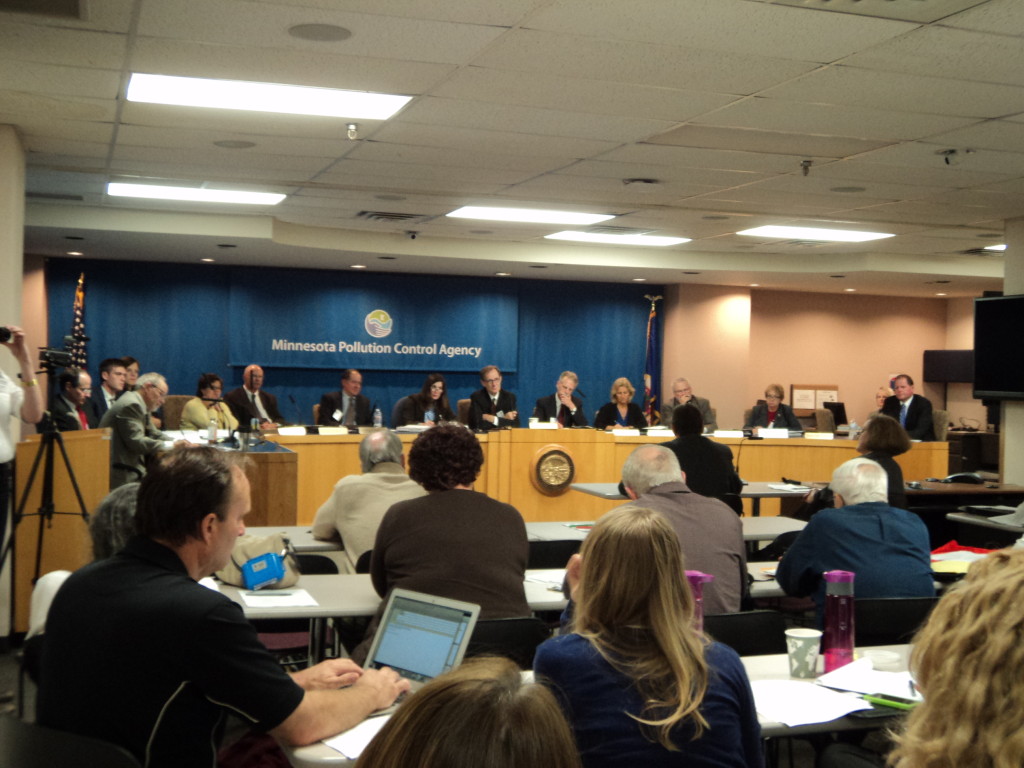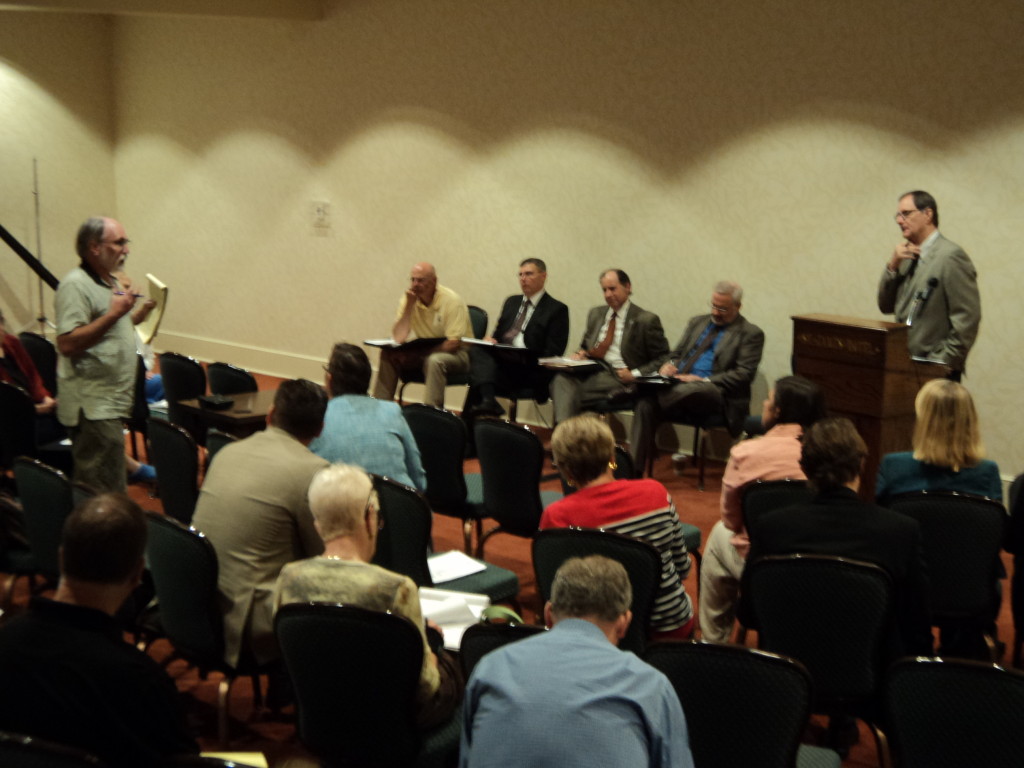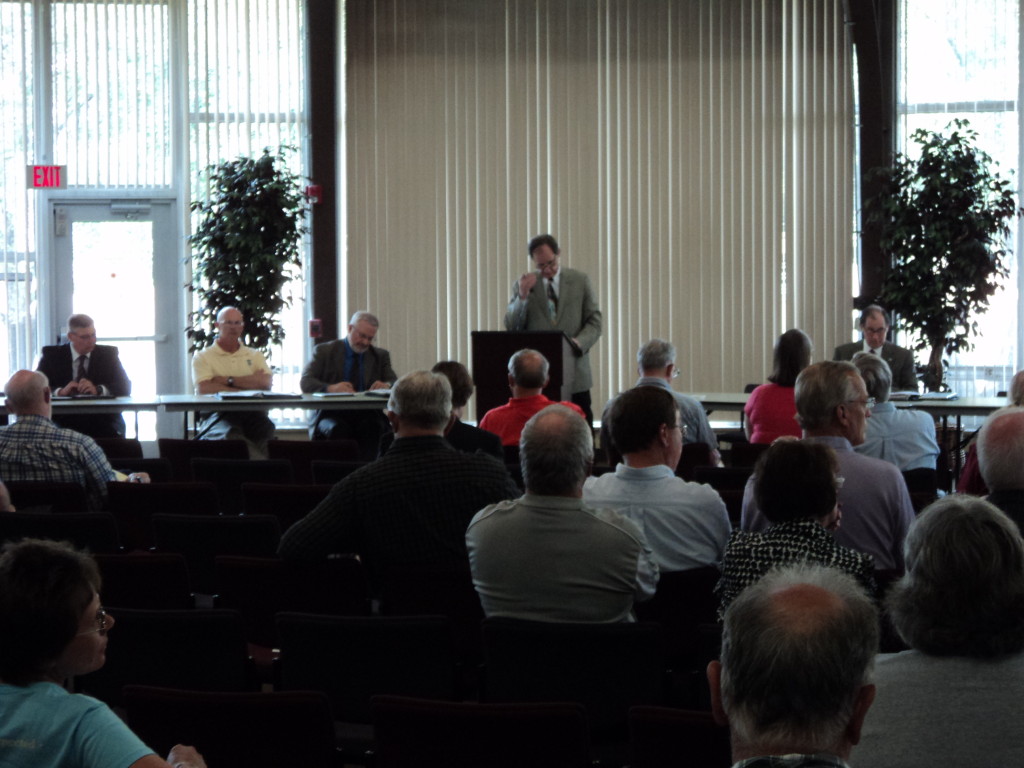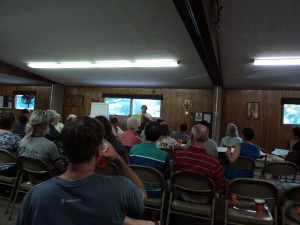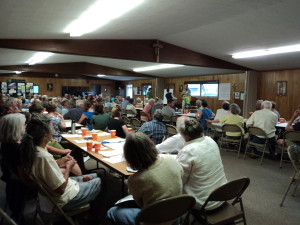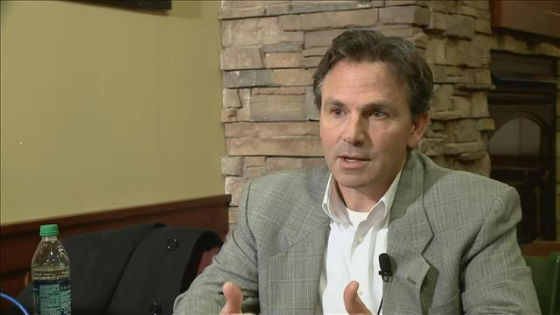EQB meeting on frac sand mining
September 21st, 2013
Wednesday was the EQB’s monthly meeting, and this one was all about frac sand mining. There are TWO things going on here. The EQB Standards and Criteria, which is not a rulemaking, and then four mandatory rulemaking tasks, two at EQB, and one each at DNR and MPCA. The EQB was supposed to deal with, at some level, both of these assignments.
One is the model Standards and Criteria, “serving suggestions” to be adopted by local government, and the other is four rulemaking tasks at three agencies:
Sec. 105. RULES; SILICA SAND.
(a) The commissioner of the Pollution Control Agency shall adopt rules pertaining to the control of particulate emissions from silica sand projects. The rulemaking is exempt from Minnesota Statutes, section 14.125.
(b) The commissioner of natural resources shall adopt rules pertaining to the reclamation of silica sand mines. The rulemaking is exempt from Minnesota Statutes, section 14.125.
(c) By January 1, 2014, the Department of Health shall adopt an air quality health-based value for silica sand.
(d) The Environmental Quality Board shall amend its rules for environmental review, adopted under Minnesota Statutes, chapter 116D, for silica sand mining and processing to take into account the increased activity in the state and concerns over the size of specific operations. The Environmental Quality Board shall consider whether
the requirements of Minnesota Statutes, section 116C.991, should remain part of the environmental review requirements for silica sand and whether the requirements should be different for different geographic areas of the state. The rulemaking is exempt from Minnesota Statutes, section 14.125.
++++++++++++++++++++++++
Minnesota Department of Natural Resources_Notice of Rulemaking
Both require public input, both have not had enough! It’s our job to make that happen, to get local governments, grassroots groups, and members of the public hollering, kicking and screaming with specific suggestions for developing the protections for us, our communities and natural resources of the areas affected by frac sand mining.
The EQB staff proposed 500 foot setbacks from homes – here’s what that would look like at the capitol (given to me by Donna Buckbee, made by Kelly Stanage!) with the setbacks proposed:
Here’s the EQB packet:
As you can see from my Sept 7 comments above, I was not at all happy with staff Jeff Smyser’s comments about an Advisory Committee, from what he said, he was either clueless, misdirecting/misinforming the EQB, or both.
From the packet, p. 6 of 34:
i. Staff requests Board direction on a question that arose at the August 2nd public meetings.
Members of the public expressed interest in a citizen committee to participate in the rulemaking. It is not clear how a citizen committee would affect the rulemaking process laid out in Minn. Statutes Ch. 14. A multi-step public review and comment process is already required in that statute and we just completed the preliminary step. Rulemaking is essentially creating law: Minnesota Rules have the force and effect of law. Rulemaking is a lengthy process, averaging about two years.
“It is not clear…” NO NO NO! For someone in Smyser’s position, there’s no excuse for statements like this. The statute is very clear about the agencies’ authority to appoint an Advisory Committees and how an advisory committee it would affect rulemaking – it improves the output by providing input before the draft rule is issued:
Not good… and WORSE when Smyser repeated that line at the meeting, I almost got up and hollered, but I got a chance to make a comment during the meeting, so I waited until then. Earth to EQB, Advisory Committees are common, the norm, in rulemaking proceedings, so get with it!! You’ve got a rulemaking mandate and you need to get moving on it.
The staff had asked for “direction” on a rulemaking committee in their comments in the packet, and the Board never did say anything about it, no discussion and no recommendation.
The meeting got off to a hilarious start, for me anyway! I’d found a table in the back, a good observation location, and plopped my stuff down and wandered around a bit, signing up to speak, and a bit of meet & greet. When I went back, who do you think had taken up the other three spots at my table? Yes, the flacks from the Industrial Sand Council (who as lobbyists are listed under Aggregate Ready Mix Ass.) Peder Larson, _______, and…. (drum roll here!) Dennis Egan right next to me!
Sally Jo Sorensen thinks he was doing a grumpy cat at the meeting
Grumpy? NO ONE was happy with the outcome of that meeting. And that’s not only how it was from our table at the back of the room! Egan is just doing what lobbyists, and really all of us in the room, were doing — advocating for our interests. The good news is that now it’s clear where Egan’s interests are. Disclosure is everything, and failure to disclose was his problem.
The first Industrial Sand speaker was dreadful, going on and on, naming all the folks on EQB that they’d met with, lording it over about their special access to these officials — time to exercise some scripting because this guy clearly does NOT understand the impact of his statements alluding to exertions of their influence (ex parte? Unfortunately I can’t find rules about that for EQB), and they’re really pissing off folks in the audience, and probably making their EQB targets uncomfortable too. If he worked for me, I’d put him on the sidelines.
After some ice breaking with Egan (I suggested that in a photo op we could strangle each other!), we did find some common ground, such as incredulous snorts over Chair Fredrickson’s asking what the deadline would be for the “second draft” of Standards and Criteria. Second draft?? Chair, the statutory deadline for finished product is October 1st. Oh well, now they’re talking about February. Bizarre, guess the statute doesn’t mean anything. Guess that also means we’re not getting to public review and comment any time soon… which means WE’D BETTER COMMENT NOW! Before they issue anything for public comment.
Egan was not testifying Wednesday, and he talked publicly only via Stephanie Hemphill, MPR:
About the EQB’s failure to meet the October 1 deadline, that was pretty much the opinion of all of us in the audience, Sen. Matt Schmit too!
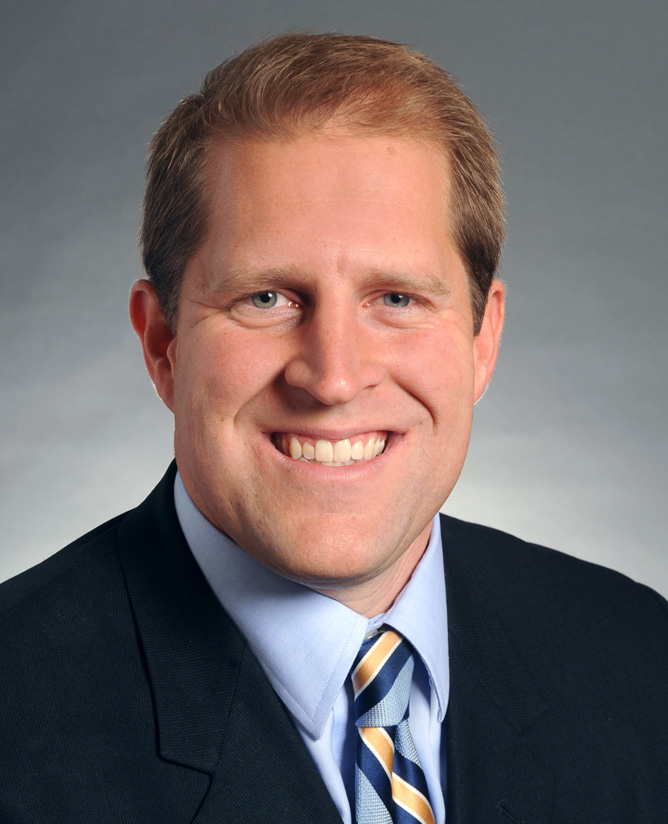
Obviously more time is needed to do a good job, and the EQB’s out-of-the-gate performance left a LOT to be desired. But about that deadline, see Minnesota Session Laws, Ch. 114:
(a) By October 1, 2013, the Environmental Quality Board, in consultation with local units of government, shall develop model standards and criteria for mining, processing, and transporting silica sand. These standards and criteria may be used by local units of government in developing local ordinances. The standards and criteria shall be different for different geographic areas of the state.
So let’s get some meetings scheduled around the state, the areas of the state affected by silica sand mining, present or proposed.
And once more with feeling, there are TWO things going on here. One, the EQB Standards and Criteria, which is not a rulemaking, and then secondly, four mandatory rulemaking tasks, two at EQB, and one each at DNR and MPCA.
Yesterday in Red Wing and Winona
August 3rd, 2013
Yesterday two meetings were held by the the Environmental Quality Board, Dept. of Natural Resources, Minnesota Pollution Control Agency, Dept. of Health, and Dept. of Transportation, and the Gov.’s Ellen Anderson, joined by a large crew of agency staff and a good sampling of county, city and township officials — good to see a crew from Red Wing and Goodhue County. The MPCA’s Stine has been on Alan’s list for some time, and we’ve been dealing with him a lot lately, the EQB and Ellen Anderson too, and I think it helps to be able to have some history with them and get right to business.
A good time was had by all. The agency reps appeared more engaged and tracking than they usually are, and you could dance to it — I’ll give it a 98. But come on… not even coffee… granted I was up at “too early o’clock” to finish my handout, but… zzzzzzzzzzzz…
Notice of these meetings was a problem, or rather, lack of notice, because this was a stage where public participation is crucial — they need to know we care and can contribute. They wanted it kept to “local governments,” but that doesn’t cut it, this is a public meeting about an immediate and high-profile issue. It must be open. There’s no excuse for keeping it under wraps.
The most important thing I heard was repeated comments by Jon Linc Stine, MPCA, in particular, was whether local governments had taken advantage of the new legislative option to extend a moratorium. At the Red Wing meeting, Goodhue County had Lisa Hanni responding for the county. Hanni was dodging and weaving on that moratorium question, stating that they acted based on the law as it was, that they had to get their work done on the timeline of their moratorium. I’d sure have appreciated the addition of a simple statement that the County would take that suggestion of extending the moritorium under advisement!!! State agency officials have a typically hands off approach to local units of government, there are turf issues here, but the repeated questions and statements encouraging extension of the moratorium are as close to a direct statement as I’ve ever seen. There was encouragement to check with attorneys about extension, and encouragement for local governments to participate in this state process — they’re looking for input — so let’s give it to them!!!
Prior to the meeting, I drafted a letter and proposed standards and criteria, off the cuff suggestions to get the ball rolling. In the letter, there were two important requests:
- Appointment of a rulemaking Advisory Committee.
- No state permitting of silica sand mines until Standards & Criteria AND rules are completed.
Here are the Comments of Winona County Citizens Concerned About Silica Mining:
CASM Comments August 2, 2013
At the Red Wing meeting, I was particularly encouraged to note that Richard Peterson from a township in Le Sueur County was there to discuss what it’s like to live with a mine next door. Specific points were that despite a provision for an “annual review,” the community received no notification that the annual review was happening! Blasting was an issue because they are blasting constantly. Reclamation is not keeping up, and they’re piling up large piles, 600 FOOT PILES, and not capping it, so the wind is blowing it all around. I’m glad someone near the Minnesota River mines was here, and hope the state will schedule meetings there, and also near the St. Croix mines. It’s not just SE Minnesota, folks, this is a far broader problem (map from StPPP)

James Riddle spoke at the Winona meeting. He’s from Winona, and has recently been appointed to the MPCA Citizens Board, and had quite a back and forth regarding trout streams, protected areas, and groundwater.
One thing they’ll be doing is providing notice to local governments, AND I HOPE THE PUBLIC, of pre-application meetings with the agencies so that local governments will have a heads up. That’s important because if there is an application to a local government, there’s only a 60 day window to act, and that’s just not enough time for permit review of something with potential for such extensive impacts.
Something that came up repeatedly was counties ability to work together on road issues, to jointly institute road impact fees, and the DOT will be digging up more information about this. That’s good because road impacts is an issue mandated for Standards and Criteria development.
Also, reclamation was a recurring issue, and the importance of reclamation standards and requirements to keep up with destruction, and also to address dormancy, if the mine just sits, how long can it sit before reclamation kicks in.
It was a great relief to have the DOT COMMISSIONER there, that’s Charles Zelle. The DOT isn’t directly involved in rulemaking mandated in the statute, but transportation is such an important issue here with potential for major impacts. And the Commissioner is a better choice to represent the agency. At past meetings we’ve seen that awful Dave Christian, who was a frac sand mining toady, actively advocating for sand mining (he said he has family or friends involved in mining … own land? An inappropriate role as he wears his DOT hat. Perhaps, as with Dennis Egan, he should be fired.). Zelle was up on some issues, and others he needs to do some research, and particularly he should take a drive through Winona on the haul routes, look at the piles, and head down Highway 76 between Houston and Caledonia during hauling times!
Here’s the write up of the meetings in the Roch PB:
State enters silica sand fracas
John Weiss, weiss@postbulletin.com | Posted: Friday, August 2, 2013 9:30 pm
RED WING Louy Stambaugh wants state agencies to help stop many trucks loaded with silica sand from pounding past her Lake City home.
“We need more help, we need some more leverage because we’re small,” she said.
Tthe EQB is made up mostly of heads of the agencies, including those at the Friday meetings.
Frac sand mining – last night in Rushford
July 10th, 2013
Let’s hear it for LAND STEWARDSHIP PROJECT! Last night they held a meeting in Rushford, packed, almost ran out of chairs, good to see so many who want to take action against the frac sand mining push to sell our part of the world to oil and gas companies. People get that the biggest issue here is corporate control and greed.
This meeting was lead by LSP’s Johanna Rupprecht, Megan Buckingham, and Doug Nopar, with LSP member activists Vince Ready, Barb Nelson, and Marilyn Frauenkron Bayer, and overall, it was well worth the drive. It’s that same warm fuzzy feeling as filling a Taconite, MN gym on a -20 degree day, only warmer!
There are at least 11 mines proposed by Minnesota Sands that are subject to an Environmental Impact Statement, 615.31 acres, phased and connected actions under the Minnesota Rules and subject to a Mandatory Environmental Impact Statement because it’s over the 160 acre threshold. Minn. R. 4410.4400, Subp. 9(B).
The EQB determined that these mines would indeed require an EIS (the mining companies try to say it’s “voluntary,” how good of them, but it’s not voluntary, it’s MANDATORY) in March.
There are a few things that I think need to be done, information that needed in the public domain:
- File a Data Practices Act Request with the EQB and do a quick file review to find out what’s been going on with these projects thus far. The public is left out of the “pre-application” discussions.
- Make sure the EIS scope is broad, and that the EQB doesn’t release a one-sided scope proposal that would take an act of Congress to alter… or a lawsuit!
- Details of ownership, who owns these projects, who is behind these projects, and how do these projects own!!! Who in the community and which of “the deciders” are being paid by the mining companies. Remember Dennis Egan, former Mayor of Red Wing? Who else is in their employ, direct or indirect? We need to know about these connections and obligations:
April Fool on April Fools Day!
Rochester Chamber: Egan, Broberg & others on frac sand
Where’s the Mayor’s resignation letter?
7p TONIGHT – Red Wing City Council Meeting
Mayor Egan to resign? Sand mining bill introduced!
Last Mayor Egan post before Council meeting
KARE 11 turns up the heat on RW Mayor Egan
Mayor Egan – the voice of frac sand mining!
Cherryholmes a lobbyist for Covanta!
April 9th, 2013
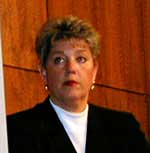 Jackie Cherryholmes, stolen Fair Use from MPR
Jackie Cherryholmes, stolen Fair Use from MPR
Oh my, Jackie Cherryholmes, running for Mayor of Minneapolis, went and did a “Dennis Egan.”
There’s nothing better than when an industry hired gun goes and blows it, when given a choice to do the right thing they just can’t manage to do it, showing their lack of ethics and character for all the world to see.
What do we see? That Jackie Cherryholmes was a registered lobbyist for Covanta, the evil promoter and operator of the HERC garbage burner that is now trying to get their garbage burning capacity increased, asking to burn more garbage and spread toxic emissions over Minneapolis. A big thanks to the STrib for getting this out into the open.
From the Campaign Finance Board:
Covanta spent $80,000 lobbying in 2012, 2011 and 2010, and $40,000 in 2009.
On February 16, 2013, Cherryholmes announced she was running for Mayor of Minneapolis.
On March 1, 2013, she terminated as lobbyist for Covanta on Leg/Metro issues. She’d registered as Covanta lobbyist on February 15, 2011, just over two years prior.
Cherryholmes also terminated as lobbyist for M.A. Mortenson that same day. What about entities such as Minneapolis Refuse? Others? Do others have interests before the City of Minneapolis?
In the STrib today:
Cherryhomes omits a detail in support for burning more trash
Posted by: Maya Rao under Politics and government Updated: April 8, 2013 – 6:55 PM
She said she had never lobbied City Council in connection with Covanta.
April Fool on April Fools Day!
April 1st, 2013
Bubble in the natural gas fracking world? Is the fracking boom about to go BOOM? From AlterNet:
Is Natural Gas the Next Bubble? Has Fracking Promised More Than It Can Deliver?
In this weekend’s Red Wing Republican Eagle — they edited my headline, this is the original, because my view of this is that those writing about how he is being abused, it’s a lynching, etc. are ignoring the crucial fact that he had the choice to disclose but he did not. Let’s see what happens today:
It’s about disclosure!
